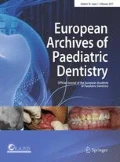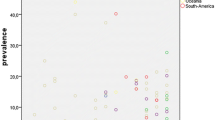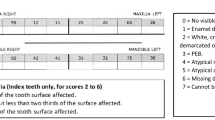Abstract
BACKGROUND: The European Academy of Paediatric Dentistry (EAPD) has long recognised the necessity of promoting further research and knowledge regarding the dental defect described as molar-incisor-hypomineralisation (MIH). Following the establishment by EAPD of the defect diagnostic criteria in 2003, the publication of various papers and a whole issue assigned to the defect in the European Archives of Paediatric Dentistry (2008), an Interim Seminar and Workshop on MIH was organized in Helsinki in 2009. RESULT: The outcome of this event is the present consensus paper on the prevalence, diagnosis, aetiology and treatment for children and adolescents presenting with MIH. A clear diagnostic proposal and a treatment decision-making guide are presented together with suggestions on aetiology and guidance forfuture research. CONCLUSION: MIH is an important clinical problem that often concerns both the general dental and specialist paediatric dentists; the present ‘best clinical practice guidance’ aims to further help clinicians dealing with the condition.
Similar content being viewed by others
References
Alaluusua S. Aetiology of Molar-Incisor Hypomineralisation. A systematic review. Eur Archs Paediatr Dent 2010; 10: 53–58
American Academy of Paediatric Dentistry. Guideline on Paediatric Restorative Dentistry. Reference Manual 2008; 163–169.
Azarpazhooh A, Limeback H. Clinical efficacy of casein derivatives: a systematic review of the literature. J Am Dent Assoc. 2008; 139(7): 915–24.
Fagrell TG, Lingström P, Olsson S, Steiniger R Norén JG. Bacterial invasion of dentinal tubules beneath apparently intact but hypomineralized enamel in molar teeth with molar incisor hypomineralisation. Int J Paediatr Dent. 2008; 18(5): 333–40.
Fayle SA. Molar incisor hypomineralisation: restorative management. Eur J Paediatr Dent. 2003; 4: 121–126.
Innes NP, Stirrups DR, Evans DJ, Hall N, Leggate M. A novel technique using preformed metal crowns for managing carious primary molars in general practice — a retrospective analysis. Br.Dent J. 2006; (8): 451–454.
Jälevik B, Noren J G. Enamel hypomineralisation of permanent first molars: a morphological study and survey of possible aetiological factors. Int J Paediatr Dent 2000; 10: 278–289.
Jälevik, B. Klingberg G. A. Dental treatment, dental fear and behaviour management problems in children with severe enamel hypomineralisation of their permanent first molars. Int J Paediatr Dent 2002; 12(1): 24–32.
Jälevik B, Moller M. Evaluation of spontaneous space closure and development of permanent dentition after extraction of hypomineralised permanent first molars. Int J Paediatr Dent 2007; 17: 328–335.
Jälevik B. Prevalence and Diagnosis of Molar-Incisor-Hypomineralisation (MIH). A systematic review. Eur Archs Paediatr Dent 2010; 10: 59–64
Joiner A. The bleaching of teeth: A review of the literature. J Dent. 2006; 34: 412–419.
Koch MJ, Garcia-Godoy F. The clinical performance of laboratory-fabricated crowns placed on first permanent molars with developmental defects. J Am Dent Assoc 2000; 131(9): 1285–90.
Kotsanos N, Kaklamanos EG, Arapostathis K. Treatment management of first permanent molars in children with Molar-Incisor Hypomineralisation. Eur J Paediatr Dent 2005; 6(4): 179–84.
Lygidakis NA, Chaliasou A, Siounas G. Evaluation of composite restorations in hypomineralised permanent molars: a four-year clinical trial. Eur J Paediatr Dent 2003; 4(3): 143–148.
Lygidakis NA, Dimou G, Stamataki E. Retention of fissure sealants using two different methods of application in children with hypomineralised molars (MIH): A 4 year clinical study. Eur Arch Paediatr Dent. 2009; 10(4): 223–6.
Lygidakis NA. Treatment modalities in children with teeth affected by molarincisor-hypomineralisation (MIH): A systematic review. Eur Arch Paediatr Dent. 2010; 11: 65–74
Mathu-Muju K, Wright JT. Diagnosis and treatment of molar incisor hypomineralisation. Compend Contin Educ Dent 2006; 27(11): 604–10.
Mejare I, Bergman E, Grindefjord M. Hypomineralized molars and incisors of unknown origin: treatment outcome at age 18 years. Int J Paediatr Dent 2005; 15: 20–28.
Sapir S, Shapira J. Clinical solutions for developmental defects of enamel and dentin in children. Pediatr Dent 2007; 29(4): 330–6.
Shen P, Cai F, Nowicki A, Vincent J, Reynolds E C. Remineralisation of enamel subsurface lesions by sugar-free chewing gum containing Casein Phosphopeptide-Amorphous calcium phosphate. J Dent Res 2001; 80: 2066–2070.
Sundfeld RH, Croll TP, Briso AL, de Alexandre RS, Sundfeld Neto D. Considerations about enamel microabrasion after 18 years. Am J Dent. 2007; 20(2): 67–72.
Weerheijm KL. Molar incisor hypomineralisation (MIH): clinical presentation, aetiology and management. Dent Update 2004; 31(1): 9–12.
Weerheijm KL, Duggal M, Mejare I, et al. Judgement criteria for Molar-Incisor-Hypomineralisation (MIH) in epidemiologic studies: a summary of the European meeting on MIH held in Athens, 2003. Eur Archs Paediatr Dent 2003; 3: 110–113.
William V, Burrow MF, Palamara JE, Messer L. Microshear bond strength of resin composite to teeth affected by molar hypomineralisation using 2 adhesive systems. Pediatr Dent 2006; 28: 233–241.
Williams JK, Gowans AJ. Hypomineralised first permanent molars and the orthodontist. Eur J Paediatr Dent 2003; 4: 129–132.
Willmott NS, Bryan RA, Duggal MS. Molar-incisor-hypomineralisation: a literature review. Eur Arch Paediatr Dent. 2008; 9(4): 172–9.
Wong FS, Winter GB Effectiveness of microabrasion technique for improvement of dental aesthetics. Br. Dent. J. 2002; 193(3): 155–158.
Wray A, Welbury R UK National Clinical Guidelines in Paediatric Dentistry: Treatment of intrinsic discoloration in permanent anterior teeth in children and adolescents. Int J Paediatr Dent 2001; 11(4): 309–15
Wright JT. The etch-bleach-seal technique for managing stained enamel defects in young permanent incisors. Pediatr Dent 2002; 24: 249–252.
Zagdwon AM, Fayle SA, Pollard MA. A prospective clinical trial comparing preformed metal crowns and cast restorations for defective first permanent molars. Eur J Paediatr Dent 2003; 4: 138–142.
Author information
Authors and Affiliations
Corresponding author
Rights and permissions
About this article
Cite this article
Lygidakis, N.A., Wong, F., Jälevik, B. et al. Best Clinical Practice Guidance for clinicians dealing with children presenting with Molar-Incisor-Hypomineralisation (MIH). Eur Arch Paediatr Dent 11, 75–81 (2010). https://doi.org/10.1007/BF03262716
Published:
Issue Date:
DOI: https://doi.org/10.1007/BF03262716




